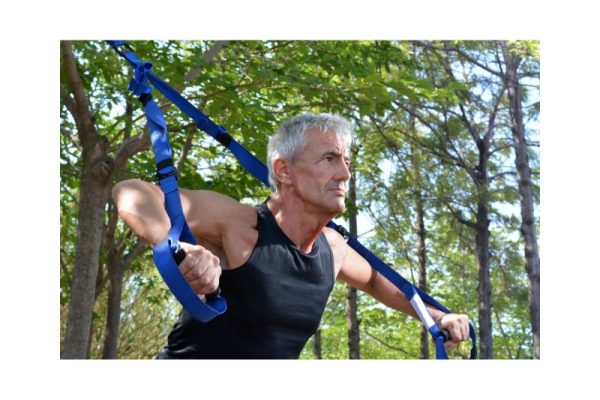Break the Muscle Barrier: How Creatine Helps Men Over 50 Reduce Myostatin and Build Strength
Understanding the Hormone That Blocks Your Gains
As men enter their 50s and beyond, muscle growth becomes more challenging due to hormonal and cellular changes. A significant barrier to building muscle is the hormone myostatin, a powerful inhibitor of muscle growth. Even with a disciplined training regimen, elevated myostatin levels can blunt the body’s ability to gain muscle mass and strength—a key concern for aging men seeking to maintain vitality, mobility, and metabolic health.
Myostatin, also known as GDF-8 (growth differentiation factor-8), is a member of the TGF-β (transforming growth factor beta) superfamily. Its biological role is to regulate skeletal muscle size by suppressing muscle cell proliferation and differentiation (Lee & McPherron, 2001). While it prevents uncontrolled muscle growth, elevated levels later in life can accelerate sarcopenia, the age-related loss of muscle mass and function.
The good news? Scientific evidence shows that creatine supplementation—particularly when combined with resistance training—can lower myostatin expression, enabling older men to overcome physiological barriers to muscle growth.
How Creatine Affects Myostatin
What Is Creatine?
Creatine is a naturally occurring compound found in skeletal muscle and synthesized from the amino acids arginine, glycine, and methionine. It plays a central role in the phosphocreatine energy system, which rapidly regenerates ATP (adenosine triphosphate), the body’s primary energy molecule during high-intensity activities.
Creatine Reduces Myostatin Expression
A key study by Safdar et al. (2010) showed that resistance training combined with creatine supplementation significantly downregulated myostatin gene expression in older men. Participants taking creatine exhibited greater satellite cell activation, improved protein synthesis, and enhanced muscle hypertrophy compared to those training without it.
Another pivotal study by Rathmacher et al. (2012) demonstrated that creatine monohydrate supplementation over 12 weeks led to suppressed myostatin levels and increased lean muscle mass in aging adults during strength training programs.
These findings suggest that creatine doesn’t just fuel workouts—it actively promotes muscle growth by interfering with the myostatin signaling pathway.
Learn more in our detailed breakdown of how creatine supports muscle growth in older men.
The Best Workout Type for Reducing Myostatin
Why Resistance Training Is Essential

The most effective training method to counteract myostatin is resistance training, especially when it includes eccentric loading (the lengthening phase of muscle contraction). Resistance training stimulates mechanotransduction, triggering intracellular signals that suppress myostatin and activate muscle repair and hypertrophy pathways (Brook et al., 2016).
A meta-analysis by Chilibeck et al. (2017) confirmed that older adults who practiced resistance training with creatine supplementation had significantly greater increases in muscle mass and strength compared to training or creatine alone.
Structure for Men Over 50
To reduce myostatin and build muscle effectively, workouts should include:
- Frequency: 3–4 days per week
- Reps/Sets: 3–4 sets of 8–12 reps
- Rest Time: 60–90 seconds between sets
- Exercises: Compound movements like squats, deadlifts, rows, and chest presses
- Tempo: Emphasize slow, controlled eccentric phases (3–4 seconds)

For a sample 4-week hypertrophy program for men over 50, read our guide on resistance training routines with creatine.
The Role of Sleep in Muscle and Hormone Health
Sleep is an often-overlooked but critical component of muscle health and hormonal balance. Deep sleep supports the release of growth hormone and the suppression of catabolic hormones like cortisol, both of which influence myostatin activity.
According to Dattilo et al. (2011), chronic sleep deprivation impairs protein synthesis and enhances proteolytic pathways, including the ubiquitin–proteasome system, leading to muscle degradation.
Optimal Sleep Strategy for Men Over 50
- Duration: 7–9 hours per night
- Quality: Aim for deep, uninterrupted sleep
- Environment: Cool, dark, and quiet
- Sleep hygiene: Avoid caffeine and screen use 2 hours before bedtime
Explore the link between sleep and muscle recovery in older men.
Nutrition and Supplement Timing to Maximise Results
Creatine Timing: When to Take It
The best time to take creatine is immediately after your workout. A 2013 study by Candow et al. found that post-workout creatine intake leads to greater lean mass gains than pre-workout consumption.
On non-training days, consistency matters more than timing. Take creatine with a meal to support absorption.
Macronutrient Needs
To support muscle growth and hormone regulation, men over 50 should prioritise:
- Protein: 1.6–2.2 g/kg/day (e.g., whey, eggs, lean meats)
- Carbohydrates: Support energy during workouts and insulin-mediated creatine uptake
- Fats: Especially omega-3s for inflammation control and hormone support
A study by Devries and Phillips (2014) showed that combining high-protein diets with creatine results in synergistic muscle-building effects in older populations.
Long-Term Myostatin Management and Healthspan
While creatine and strength training are effective for short-term myostatin suppression, maintaining long-term muscle health requires a sustainable lifestyle that includes:
- Consistent training cycles with progressive overload
- Recovery weeks or deload phases
- Anti-inflammatory nutrition, including antioxidants and healthy fats
- Stress management, as cortisol may indirectly influence myostatin pathways
Emerging research is exploring myostatin inhibitors, such as follistatin and gene therapies, but these remain experimental and are not currently approved for public use due to safety concerns (Rodgers & Garikipati, 2008).
Learn more about the science of myostatin and muscle regulation.
Conclusion: Reclaiming Muscle in Your 50s and Beyond

The age-related rise in myostatin creates a significant obstacle for men seeking to maintain or build muscle after 50. However, a combination of creatine supplementation, structured resistance training, and supportive lifestyle practices like sleep and nutrition provides a powerful, science-backed way to suppress myostatin and unlock your body’s full potential.
Action Plan:
- Take 3–5g of creatine monohydrate daily
- Train 3–4x per week with progressive resistance workouts
- Sleep 7–9 hours per night
- Eat a high-protein, anti-inflammatory diet
- Track your strength and energy gains monthly
With consistency and the right science-backed strategy, you can build strength, stay vital, and thrive in the decades to come.
References
- Candow, D. G., Vogt, E., Johannsmeyer, S., Forbes, S. C., & Farthing, J. P. (2013). Strategic creatine supplementation and resistance training in healthy older adults. Applied Physiology, Nutrition, and Metabolism, 38(7), 768–775. https://doi.org/10.1139/apnm-2012-0371
- Chilibeck, P. D., Kaviani, M., Candow, D. G., & Zello, G. A. (2017). Effect of creatine supplementation during resistance training on lean tissue mass and muscular strength in older adults: A meta-analysis. Open Access Journal of Sports Medicine, 8, 213–226. https://doi.org/10.2147/OAJSM.S123529
- Dattilo, M., Antunes, H. K. M., Medeiros, A., et al. (2011). Sleep and muscle recovery: endocrinological and molecular basis for a new and promising hypothesis. Medical Hypotheses, 77(2), 220–222. https://doi.org/10.1016/j.mehy.2011.04.017
- Devries, M. C., & Phillips, S. M. (2014). Creatine supplementation during resistance training in older adults—a meta-analysis. Medicine & Science in Sports & Exercise, 46(6), 1194–1203. https://doi.org/10.1249/MSS.0000000000000220
- Safdar, A., Yardley, N. J., Snow, R., Melov, S., & Tarnopolsky, M. A. (2010). Global and targeted gene expression and protein content in skeletal muscle of young men following resistance exercise with or without creatine monohydrate supplementation. Physiological Genomics, 40(3), 141–159. https://doi.org/10.1152/physiolgenomics.00111.2009
- Rodgers, B. D., & Garikipati, D. K. (2008). Clinical, agricultural, and evolutionary biology of myostatin: a comparative review. Endocrine Reviews, 29(5), 513–534. https://doi.org/10.1210/er.2007-0039
No related posts.

